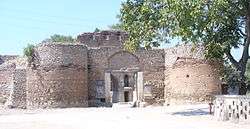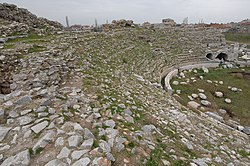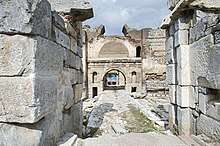Nicaea
Nicaea or Nicea (/naɪˈsiːə/; Greek: Νίκαια, Níkaia) was an ancient Greek city in northwestern Anatolia and is primarily known as the site of the First and Second Councils of Nicaea (the first and seventh Ecumenical councils in the early history of the Christian Church), the Nicene Creed (which comes from the First Council), and as the capital city of the Empire of Nicaea following the Fourth Crusade in 1204, until the recapture of Constantinople by the Byzantines in 1261.
Νίκαια | |
 | |
 Location of Nicaea within Turkey. | |
| Coordinates | 40°25.74′N 29°43.17′E |
|---|---|
The ancient city is located within the modern Turkish city of İznik (whose modern name derives from Nicaea's), and is situated in a fertile basin at the eastern end of Lake Ascanius, bounded by ranges of hills to the north and south. It is situated with its west wall rising from the lake itself, providing both protection from siege from that direction, as well as a source of supplies which would be difficult to cut off. The lake is large enough that it could not be blockaded from the land easily, and the city was large enough to make any attempt to reach the harbour from shore-based siege weapons very difficult.
The ancient city is surrounded on all sides by 5 kilometres (3 mi) of walls about 10 metres (33 ft) high. These are in turn surrounded by a double ditch on the land portions, and also included over 100 towers in various locations. Large gates on the three landbound sides of the walls provided the only entrance to the city.
Today the walls have been pierced in many places for roads, but much of the early work survives and, as a result, it is a tourist destination.
History
Early history
.jpg)

The place is said to have been colonized by Bottiaeans, and to have originally borne the name of Ancore (Ἀγκόρη) or Helicore (Ἑλικόρη), or by soldiers of Alexander the Great's army who hailed from Nicaea in Locris, near Thermopylae. The later version however was not widespread even in Antiquity.[1] Whatever the truth, the first Greek colony on the site was probably destroyed by the Mysians, and it fell to Antigonus I Monophthalmus, one of Alexander's successors (Diadochi) to refound the city ca. 315 BC as Antigoneia (Ἀντιγονεία) after himself. Antigonus is also known to have established Bottiaean soldiers in the vicinity, lending credence to the tradition about the city's founding by Bottiaeans. Following Antigonus' defeat and death at the Battle of Ipsus in 301 BC, the city was captured by Lysimachus, who renamed it Nicaea (Νίκαια, also transliterated as Nikaia or Nicæa; see also List of traditional Greek place names), in tribute to his wife Nicaea, who had recently died.[1]
Sometime before 280 BC, the city came under the control of the local dynasty of the kings of Bithynia. This marks the beginning of its rise to prominence as a seat of the royal court, as well as of its rivalry with Nicomedia. The two cities' dispute over which one was the pre-eminent city (signified by the appellation metropolis) of Bithynia continued for centuries, and the 38th oration of Dio Chrysostom was expressly composed to settle the dispute.[2][3]
Plutarch, mentioned that Menecrates (Μενεκράτης) wrote about the history of the city.[4]
Roman period

Along with the rest of Bithynia, Nicaea came under the rule of the Roman Republic in 72 BC. The city remained one of the most important urban centres of Asia Minor throughout the Roman period, and continued its old competition with Nicomedia over pre-eminence and the location of the seat of the Roman governor of Bithynia et Pontus.[2] The geographer Strabo (XII.565 ff.) described the city as built in the typical Hellenistic fashion with great regularity, in the form of a square, measuring 16 stadia in circumference, i.e. approx. 700 m × 700 m (2,297 ft × 2,297 ft) or 0.7 km × 0.7 km (0.43 mi × 0.43 mi) covering an area of some 50 ha (124 acres) or 0.5 km2 (0.2 sq mi); it had four gates, and all its streets intersected one another at right angles in accordance with the Hippodamian plan, so that from a monument in the centre all the four gates could be seen.[3][5] This monument stood in the gymnasium, which was destroyed by fire but was restored with increased magnificence by Pliny the Younger, when he was governor there in the early 2nd century AD. In his writings Pliny makes frequent mention of Nicaea and its public buildings.[3]
Emperor Hadrian visited the city in 123 AD after it had been severely damaged by an earthquake and began to rebuild it. The new city was enclosed by a polygonal wall of some 5 kilometres in length. Reconstruction was not completed until the 3rd century, and the new set of walls failed to save Nicaea from being sacked by the Goths in 258 AD.[2][5] The numerous coins of Nicaea which still exist attest the interest taken in the city by the Roman emperors, as well as its attachment to the rulers; many of them commemorate great festivals celebrated there in honour of gods and emperors, as Olympia, Isthmia, Dionysia, Pythia, Commodia, Severia, Philadelphia, etc.[3]
Byzantine period
By the 4th century, Nicaea was a large and prosperous city, and a major military and administrative centre. Emperor Constantine the Great convened the First Ecumenical Council there, and the city gave its name to the Nicene Creed.[3][6] The city remained important in the 4th century, seeing the proclamation of Emperor Valens (364) and the failed rebellion of Procopius (365). During the same period, the See of Nicaea became independent of Nicomedia and was raised to the status of a metropolitan bishopric. However, the city was hit by two major earthquakes in 363 and 368, and coupled with competition from the newly established capital of the Eastern Empire, Constantinople, it began to decline thereafter. Many of its grand civic buildings began to fall into ruin, and had to be restored in the 6th century by Emperor Justinian I.[6]
The city disappears from sources thereafter and is mentioned again in the early 8th century: in 715, the deposed emperor Anastasios II fled there, and the city successfully resisted attacks by the Umayyad Caliphate in 716 and 727.[6] The city was again damaged by the 740 Constantinople earthquake, served as the base of the rebellion of Artabasdos in 741/2, and served as the meeting-place of the Seventh Ecumenical Council, which condemned Byzantine Iconoclasm, in 787 (the council probably met in the basilica of Hagia Sophia).[7] Nicaea became the capital of the Opsician Theme in the 8th century and remained "a center of administration and trade" (C. Foss). A Jewish community is attested in the city in the 10th century. Due to its proximity to Constantinople, the city was contested in the rebellions of the 10th and 11th centuries as a base from which to threaten the capital. It was in the wake of such a rebellion, that of Nikephoros Melissenos, that it fell into the hands of Melissenos' Turkish allies in 1081.[8] The Seljuk Turks made Nicaea the capital of their possessions in Asia Minor until 1097, when it returned to Byzantine control with the aid of the First Crusade after a one month siege.[8]
The 12th century saw a period of relative stability and prosperity at Nicaea. The Komnenian emperors Alexios, John and Manuel campaigned extensively to strengthen the Byzantine presence in Asia Minor. Major fortifications were constructed across the region, especially by John and Manuel, which helped to protect the city and its fertile hinterland. There were also several military bases and colonies in the area, for example the one at Rhyndakos in Bithynia, where the emperor John spent a year training his troops in preparation for campaigns in southern Asia Minor.
After the fall of Constantinople to the Fourth Crusade in 1204, and the establishment of the Latin Empire, Nicaea escaped Latin occupation and maintained an autonomous stance. From 1206 on, it became the base of Theodore Laskaris, who in 1208 was crowned emperor there and founded the Empire of Nicaea. The Patriarchate of Constantinople, exiled from Constantinople, also took up residence in the city until the recapture of Constantinople in 1261. Although Nicaea was soon abandoned as the primary residence of the Nicaean emperors, who favoured Nymphaion and Magnesia on the Maeander, the period was a lively one in the city's history, with "frequent synods, embassies, and imperial weddings and funerals", while the influx of scholars from other parts of the Greek world made it a centre of learning as well.[8]
After the restoration of the Byzantine Empire in 1261, the city once again declined in importance. The neglect of the Asian frontier by Michael VIII Palaiologos provoked a major uprising in 1262, and in 1265, panic broke out when rumours circulated of an imminent Mongol attack.[8] Emperor Andronikos II Palaiologos visited the city in 1290 and took care to restore its defences, but Byzantium proved unable to halt the rise of the nascent Ottoman emirate in the region.[8] After Emperor Andronikos III Palaiologos and John Kantakouzenos were defeated at Pelekanon on 11 June 1329, the Byzantine government could no longer defend Nicaea. Nicaea finally surrendered to the Ottomans after a long siege 2 March 1331.[9]
Ottoman Empire
In 1331, Orhan I captured the city from the Byzantines and for a short period the town became the capital of the expanding Ottoman emirate.[10] Many of its public buildings were destroyed, and the materials were used by the Ottomans in erecting their mosques and other edifices. The large church of Hagia Sophia in the centre of the town was converted into a mosque and became known as the Orhan Mosque.[11] A madrasa and baths were built nearby.[12] In 1334 Orhan built a mosque and an imaret (soup kitchen) just outside the Yenişehir gate (Yenişehir Kapısı) on the south side of the town.[13] With the fall of Constantinople in 1453, the town lost a great degree of its importance, but later became a major centre with the creation of a local faïence pottery-making industry in the 17th century.
 İznik Walls at Yenişehir Gate
İznik Walls at Yenişehir Gate İznik Walls at Yenişehir Gate
İznik Walls at Yenişehir Gate İznik Walls at Lefke Gate
İznik Walls at Lefke Gate İznik Walls at Lefke Gate
İznik Walls at Lefke Gate İznik Walls at Istanbul Gate
İznik Walls at Istanbul Gate
Ruins
The ancient walls, with their towers and gates, are relatively well preserved. Their circumference is 3,100 m (10,171 ft), being at the base from 5 to 7 m (16 to 23 ft) in thickness, and from 10 to 13 m (33 to 43 ft) in height; they contain four large and two small gates. In most places they are formed of alternate courses of Roman tiles and large square stones, joined by a cement of great thickness. In some places columns and other architectural fragments from the ruins of more ancient edifices have been inserted. As with those of Constantinople, the walls seem to have been built in the 4th century. Some of the towers have Greek inscriptions.[14]
Eight kilometers from the city there is an ancient, human-size, Herakles relief engraved on a rock.[15]
The ruins of mosques, baths, and houses, dispersed among the gardens and apartment buildings that now occupy a great part of the space within the Roman and Byzantine fortifications, show that the Ottoman-era town center, though now less considerable, was once a place of importance; but it never was as large as the Byzantine city. It seems to have been almost entirely constructed of the remains of the Byzantine-era Nicaea, the walls of the ruined mosques and baths being full of the fragments of ancient Greek, Roman, and Byzantine temples and churches. In the northwestern parts of the town, two moles extend into the lake and form a harbour; but the lake in this part has much retreated, and left a marshy plain. Outside the walls are the remnants of an ancient aqueduct.[14]
The Church of the Dormition, the principal Greek Orthodox church in Nicaea, was one of the most architecturally important Byzantine churches in Asia Minor. A domed church with a cross-shaped nave and elongated apse, and dating from the perhaps as early as the end of the 6th century, its bema was decorated with very fine mosaics that had been restored in the 9th century. The Church of the Dormition was destroyed in 1922; only the lower portions of some of its walls survive today.[16]
Excavations are underway in the Ottoman kilns where the historic Nycean tileware were made. The Hagia Sophia of Nicaea is also undergoing restoration.
 Iznik Church remains possibly Dormition
Iznik Church remains possibly Dormition Iznik Church remains possibly Dormition
Iznik Church remains possibly Dormition Iznik Kilns excavations
Iznik Kilns excavations Iznik Kilns excavations
Iznik Kilns excavations
See of Nicaea
The bishopric of Nicaea remains as a titular see of the Roman Catholic Church,[17] which has left the seat vacant since the death of its last titular bishop in 1976.[18] It is also a titular metropolitan see of the Ecumenical Patriarchate of Constantinople. The incumbent 2001–2010 was the former Archbishop of Karelia and All Finland, Metropolitan Johannes (Rinne).[19]
Notable people
- Hipparchus (2nd century BC) Greek astronomer, geographer, and mathematician
- Sporus of Nicaea (c. 240 – c. 300) Greek mathematician and astronomer
- Georgius Pachymeres (1242 – c. 1310), Byzantine historian
- Cassius Dio (AD c.165–c.229), Roman historian
See also
References
- Stefanidou 2003, 2. Foundation, other names.
- Stefanidou 2003, 3. History.
- DGRG, Nicaea
- Plutarch, Life of Theseus, 26
- Stefanidou 2003, 5. Culture - architecture.
- Foss 1991, p. 1463.
- Foss 1991, pp. 1463–1464.
- Foss 1991, p. 1464.
- Donald M. Nicol, The Last Centuries of Byzantium, 1261-1453, second edition (Cambridge: University Press, 1993), pp. 169f
- Raby 1989, p. 19–20.
- Tsivikis, Nikolaos (23 March 2007), "Nicaea, Church of Hagia Sophia", Encyclopaedia of the Hellenic World, Asia Minor, Foundation of the Hellenic World, retrieved 20 September 2014.
- St. Sophia Museum, ArchNet, retrieved 20 September 2014.
- Raby 1989, p. 20.
- Comp. William Martin Leake, Asia Minor, pp. 10, foll.; Von Prokesch-Osten, Erinnerungen, iii. pp. 321,foll.; Richard Pococke, Journey in Asia Minor, iii. pp. 181, foll.; Walpole,'Turkey'[', ii. p. 146; Eckhel, Doctr. Num. i. pp. 423, foll.; Rasche, Lexic. Rei Num. iii. l. pp. 1374, foll.
- [https://www.hurriyetdailynews.com/2-000-year-old-hercules-relief-damaged-156765 2,000-year-old Hercules relief damaged ]
- Cyril Mango, "Byzantine Architecture", p90.
- Annuario Pontificio 2013 (Libreria Editrice Vaticana, 2013, ISBN 978-88-209-9070-1), p. 939
- Catholic-Hierarchy.org
- "Biography of Metropolitan Johannes (Rinne) of Nicea" (in Greek). Ecumenical Patriarchate of Constantinople. Retrieved 2008-10-18.
Bibliography
- Foss, Clive (1991). "Nicaea". In Kazhdan, Alexander (ed.). Oxford Dictionary of Byzantium. London and New York: Oxford University Press. pp. 1463–1464. ISBN 978-0-19-504652-6.CS1 maint: ref=harv (link)
- Stefanidou, Vera (2003). "Nicaea (Antiquity)". Encyclopaedia of the Hellenic World, Asia Minor. Foundation of the Hellenic World.CS1 maint: ref=harv (link)

External links
| Wikimedia Commons has media related to Nicaea. |
- Hazlitt, Classical Gazetteer, "Nicæa"
- T. Bekker-Nielsen, Urban Life and Local Politics in Roman Bithynia: The Small World of Dion Chrysostomos Aarhus, 2008.
- Çetinkaya, Halûk. Four Newly Discovered Churches in Bithynia. Actual Problems of Theory and History of Art: Collection of articles. Vol. 9. Ed: A. V. Zakharova, S. V. Maltseva, E. Iu. Staniukovich-Denisova. Lomonosov Moscow State University/St. Petersburg, NP-Print, 2019, pp. 244–252. ISSN 2312-2129.